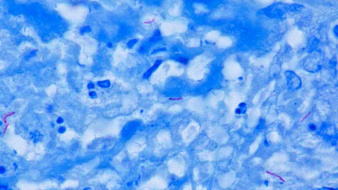
In 2015, the term of implementation of the Consolidated Action Plan to Prevent and Combat Multidrug- and Extensively Drug-Resistant Tuberculosis in the WHO European Region 2011–2015 expires. The main target of this five-year Action Plan is to prevent transmission of MDR-TB and XRD-TB by ensuring general access to services of prevention, diagnostics and treatment of MDR-TB and XRD-TB in all member-states of the European region of WHO.
From 2015 to 2020, the following goals adjusted to the Global Stop TB Strategy shall be attained:
- TB incidence decrease by 25%;
- TB mortality decrease by 35%;
- indicator of MDR-TB effective treatment not lower than 75%.
According to the preliminary conclusions of the WHO expert commission, over the last five years, a tendency towards decrease in the rate of TB incidence and mortality has been witnessed in Ukraine, optimization of laboratory network for TB diagnostics has been done, and quick diagnostics methods and system of quality control measures have been introduced, MDR-TB diagnostics has improved significantly.
Ukraine has introduced the standards for treatment of patients with TB, HIV/TB co-infection, and MDR-TB; it intensified cooperation on fighting TB/HIV co-infection, established interaction between the centers for prevention and fighting AIDS (hereinafter – the AIDS Centers) and tuberculosis facilities; laid the groundwork for implementation of TB infection control measures; and introduced the TB patient register.
The structure of the antituberculosis system of Ukraine
The UCDS supervises the implementation of the national TB and HIV programs, being a single coordination center in Ukraine for transferring data and information on these diseases. The UCDC monitoring programs pay special attention to reinforcement of relations with primary healthcare facilities and social services as a basis for public health.
The following subdivisions are growing their capabilities within the UCDC: center for monitoring and assessment of program measures, organization of medical assistance to HIV-infected persons, organization of medical assistance to TB patients, department of procurement and delivery, the National Reference-Laboratory for HIV/AIDS diagnostics with the departments of serology, immunology, and virology.
The measures to fight TB are implemented by the antituberculosis service of Ukraine, represented by tuberculosis dispensaries, tuberculosis hospitals for adults and children, and phthisiologist offices in institutions providing outpatient and polyclinic assistance.
In 2014, 82 tuberculosis dispensaries were functioning, including 67 dispensaries with inpatient departments (12,304 beds, in 2013 – 15,174 beds), where 45,795 patients have been treated, including 19,860 rural residents (in 2013 these figures were 58,280 and 22,674 respectively). The beds in tuberculosis dispensaries were occupied, on average, for 292 days, and an average hospital stay of a patient reached 79.1 days (in 2013 these figures were 312 and 82.4 respectively).
Within the MOH of Ukraine system, 33 tuberculosis hospitals for adults (4,985 beds) were functioning. They are accountable for treatment of 9,914 patients a year, including 4,420 rural residents. On average, hospital beds were occupied for 250 days a year, and an average hospital stay of a patient reached 103.5 days. In 2013, the system of the MOH of Ukraine included 36 tuberculosis hospitals for adults (5,255 beds), where 14,826 patients were treated, including 5,762 residents of rural areas; on average, hospital beds were occupied 276 days a year, and an average hospital stay of a patient reached 100.5 days.
In total, in 2014 there were 16,324 tuberculosis beds for adults in the country, where 50,133 patients were treated. In 2013, the number of tuberculosis beds for adults was 20,519, and 67,573 patients were treated.


